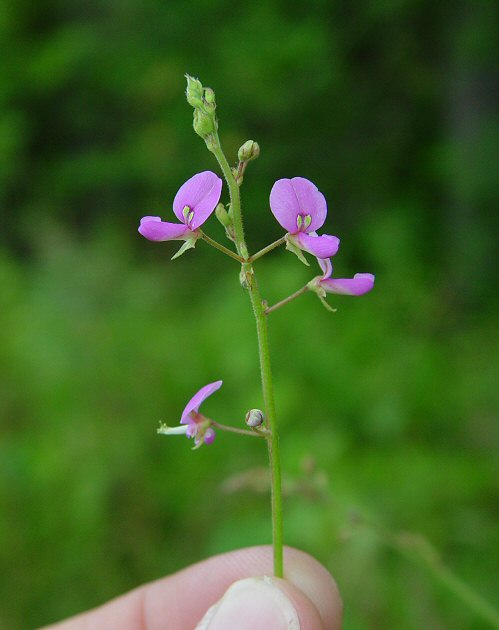Desmodium paniculatum (L.) DC.
Tall Tick Trefoil

Native
CC = 3
CW = 3
MOC = 73
© DETenaglia
Desmodium paniculatum (L.) DC.Tall Tick Trefoil | |
 |
Native CC = 3 CW = 3 MOC = 73 |
© DETenaglia |
|
Family - Fabaceae/Faboideae Stems - To 1m tall, erect to ascending or reclining, glabrous to pubescent, herbaceous, single or multiple from base, from a taproot and with a caudex.
Leaves - Alternate, trifoliolate, stipulate, petiolate. Stipules attenuate, to 8mm long, glabrous or ciliate margined. Petioles to +/-4cm long, slightly expanded at base for 2-3mm, 3-angled, glabrous to pubescent. Petiolules of lateral leaflets to 2.1mm long, pubescent. Lateral leaflets to +7cm long, +2cm broad, slightly oblique to rounded at base, acute to blunt at apex, entire, appressed pubescent (strigose) to pilose, lanceolate to narrowly ovate or oblong. Petiolule of terminal leaflet to -2cm long, thickened at base for 2mm, with pair of small stipules at base. Terminal leaflet similar to lateral leaflets.
Inflorescence - Axillary and terminal racemes or panicles to +30cm long. Pedicels to 1.2cm long in flower, dense uncinulate-pubescent, subtended by lance-attenuate bracts to 5mm long. Flowers - Corolla papilionaceous, pinkish. Standard notched at apex, with two yellowish spots near base, to 7mm long and broad. Wing petals slightly inflated. Stamens diadelphous, 6-7mm long. Ovary green, pubescent, 3mm long. Style to 2mm long. Calyx tube to +/-1mm long, puberulent, tinged with red. Upper lobe of calyx to +1.5mm long. Lower lobe of calyx with deflexed central portion to +4mm long. Loments with 3-6 segments, uncinulate-puberulent.
Flowering - July - September. Habitat - Thickets, dry upland woods, rich woods, ravines, prairies, glades, ridges, moist ground, roadsides, railroads. Origin - Native to U.S. Other info. - This species can be found throughout Missouri. The plant can be identified by its relatively small flowers, thin leaflets, and pubescent stems. There is variation in leaf size and pubescence, however, and many authors separate this species into many varieties. I won't go into those here. Photographs taken off Hwy H, Shannon County, MO., 7-30-04. |